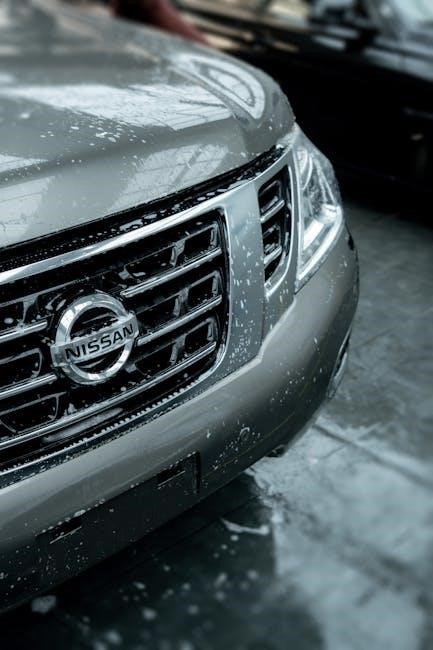
2015 toyota highlander maintenance schedule pdf
Regular maintenance is crucial for optimal performance and longevity of your 2015 Toyota Highlander. The maintenance schedule, available in the owner’s manual or as a downloadable PDF, outlines essential services, intervals, and checks to ensure your vehicle runs smoothly and prevents potential issues. By following the recommended schedule, you can maintain reliability, safety, and efficiency while adhering to Toyota’s guidelines for proper care.
Overview of the Importance of Regular Maintenance
Regular maintenance is essential for ensuring the longevity, performance, and safety of your 2015 Toyota Highlander. Neglecting scheduled services can lead to premature wear and tear, potentially causing costly repairs and compromising vehicle reliability. By following the recommended maintenance schedule, you can identify and address issues early, preventing breakdowns and ensuring optimal fuel efficiency. Regular checks also help maintain the overall health of your vehicle, ensuring all systems function as intended. Additionally, adhering to the schedule can preserve your vehicle’s warranty and resale value. The maintenance guide provides a clear roadmap for owners to follow, ensuring their Highlander remains in peak condition for years to come. Proper upkeep not only enhances driving safety but also contributes to a smoother and more enjoyable ownership experience.
Key Components of the 2015 Toyota Highlander Maintenance Schedule
The 2015 Toyota Highlander maintenance schedule is designed to ensure the vehicle’s longevity and optimal performance. Key components include regular oil changes, tire rotations, and fluid level checks to maintain engine health and prevent wear. The schedule also emphasizes inspections of critical systems, such as brakes, belts, and hoses, to identify potential issues early. Additionally, it outlines recommendations for air filter replacements, battery checks, and wiper blade inspections to ensure reliability. The schedule is organized by mileage intervals, providing clear guidelines for when specific services should be performed. By following these components, owners can prevent costly repairs, enhance fuel efficiency, and maintain their Highlander’s overall condition. Regular maintenance also ensures safety and performance, keeping the vehicle running smoothly for years to come.

Recommended Maintenance Intervals

The 2015 Toyota Highlander maintenance schedule includes intervals at 5,000, 15,000, 30,000, 60,000, and 90,000 miles. These intervals ensure optimal performance, prevent potential issues, and maintain reliability and safety.
5,000 Mile Service Interval
The 5,000-mile service is a fundamental checkup for your 2015 Toyota Highlander. It typically includes an oil change with Toyota-approved oil and a new filter to ensure the engine runs smoothly. Tire pressure is checked and adjusted for optimal handling and fuel efficiency. A visual inspection of essential components such as belts, hoses, and brakes is performed to identify any early signs of wear. Additionally, the battery and electrical systems are tested to confirm proper function. This interval is crucial for maintaining your vehicle’s performance and preventing unexpected repairs down the road.
15,000 Mile Service Interval
At the 15,000-mile mark, your 2015 Toyota Highlander requires a more detailed service to maintain its performance and longevity. This interval typically includes a tire rotation to ensure even tread wear and improve handling. The braking system is inspected more thoroughly, with a focus on pad thickness and rotor condition. Fluid levels, such as coolant and transmission fluid, are checked and topped off as needed. The cabin air filter is also replaced to enhance interior air quality. Additionally, the wiper blades are inspected for wear, and the exhaust system is checked for leaks or damage. This service is designed to address potential issues early and keep your Highlander running smoothly. Following this schedule helps ensure your vehicle remains reliable and efficient.
30,000 Mile Service Interval
The 30,000-mile service for your 2015 Toyota Highlander is a critical checkpoint to ensure long-term reliability. This interval includes a comprehensive inspection of belts and hoses, with a focus on their condition and wear. The battery is tested for health and charge capacity, while the coolant and transmission fluid levels are checked and topped off if necessary. Additionally, the exhaust system is inspected for leaks or damage, and the suspension and steering components are evaluated for proper alignment and function. Tire rotation and pressure checks are performed to maintain even tread wear. The air filter may also be replaced at this interval to improve engine performance and fuel efficiency. This service helps identify and address potential issues before they escalate, ensuring your Highlander continues to run smoothly and efficiently.
60,000 Mile Service Interval
The 60,000-mile service is a significant milestone for your 2015 Toyota Highlander, focusing on extending its lifespan and performance. This interval typically includes an oil change and filter replacement to maintain engine health. Coolant and transmission fluid levels are checked, and these fluids may need replacement if they show signs of degradation. The serpentine belt and other belts are inspected for cracks or wear, and the hoses are examined for leaks or softening. Spark plugs are usually replaced at this interval to ensure proper engine combustion. Brake pads and rotors are inspected for wear, and the brake fluid is checked or replaced if necessary. Tire rotation and balancing are performed to maintain even tread wear. Additionally, the exhaust system and suspension components are inspected for any damage or misalignment. This comprehensive service ensures your Highlander remains in optimal condition and prevents potential issues from arising.
90,000 Mile Service Interval
The 90,000-mile service is a critical checkpoint for your 2015 Toyota Highlander, ensuring long-term reliability and performance. At this interval, the spark plugs are typically replaced to maintain proper engine combustion. The timing belt is inspected for wear or damage, and if necessary, replaced to prevent costly engine damage. Hybrid models may require specific checks on the hybrid battery and control systems. The cooling system is evaluated for leaks or degradation, and the coolant may be replaced if needed. The exhaust system is inspected for leaks or damage, and the suspension and steering components are checked for wear. Additionally, the belts and hoses are thoroughly examined for cracks or softening, and the brake system is inspected for any issues. Tire rotation and balancing are performed, and all fluid levels are checked and topped off as required. This service ensures your Highlander remains in excellent condition and continues to perform reliably.

Essential Maintenance Services
Regular oil changes, tire rotations, and brake inspections are vital for maintaining your 2015 Toyota Highlander. These services ensure optimal performance, safety, and longevity of your vehicle.
Oil Change and Filter Replacement
Regular oil changes are crucial for the longevity and performance of your 2015 Toyota Highlander. The recommended oil change interval is every 5,000 to 7,500 miles, depending on driving conditions. Using the correct viscosity grade, such as 0W-20, ensures optimal engine lubrication and fuel efficiency. During each service, the oil filter should also be replaced to maintain clean oil flow and prevent engine damage. Refer to the maintenance schedule PDF for specific guidelines and recommendations tailored to your vehicle’s needs. Consistent oil changes help prevent engine wear, reduce emissions, and keep your Highlander running smoothly for years to come.
Tire Rotation and Pressure Check
Tire rotation and pressure checks are essential for maintaining even tread wear, improving fuel efficiency, and ensuring safe handling. The 2015 Toyota Highlander maintenance schedule recommends tire rotation every 5,000 to 15,000 miles, depending on driving conditions. Proper tire pressure, as specified in the owner’s manual or on the tire information placard, should be checked monthly and before long trips. Underinflated tires can lead to reduced fuel efficiency, uneven wear, and increased risk of tire failure. Regular rotation ensures balanced wear across all four tires, extending their lifespan and maintaining optimal vehicle performance. Refer to the maintenance schedule PDF for specific guidelines on tire care to keep your Highlander running smoothly and safely.

Brake System Inspection

A regular brake system inspection is vital for ensuring the safety and reliability of your 2015 Toyota Highlander. The maintenance schedule recommends inspecting brake components every 15,000 miles or as needed. This includes checking brake pads, rotors, and fluid levels for wear or damage. Worn brake pads or warped rotors can lead to reduced stopping power, increasing the risk of accidents. Additionally, the brake fluid should be tested for contamination and topped up if necessary. Proper maintenance helps prevent costly repairs and ensures your brakes function optimally. Refer to the maintenance schedule PDF for detailed guidelines on when and how to inspect your Highlander’s brake system to maintain its performance and your safety on the road.
Battery and Electrical System Check
A battery and electrical system check is essential to ensure your 2015 Toyota Highlander operates reliably. The maintenance schedule recommends inspecting the battery terminals for corrosion and ensuring they are securely connected. Additionally, the battery’s charge level and fluid levels should be checked to prevent unexpected failures. The electrical system, including the alternator and wiring, should also be examined for any signs of wear or damage. For hybrid models, the HV battery and associated components are covered under an 8-year/100,000-mile warranty, but regular inspections are still crucial. Addressing issues early can prevent breakdowns and ensure optimal performance. Always refer to the maintenance schedule PDF for detailed guidelines on how to maintain your Highlander’s battery and electrical system effectively.
Fluid Level Inspection and Top-Up
Regular fluid level inspections are vital for maintaining the health of your 2015 Toyota Highlander. The maintenance schedule recommends checking the engine oil, coolant, transmission fluid, and brake fluid levels during routine service visits. Inspect for any signs of leaks or contamination and top up fluids as needed. The radiator and condenser should also be checked to ensure they are free from blockages and debris. Proper fluid levels prevent overheating, engine damage, and system failures. Refer to the owner’s manual or the downloadable PDF schedule for specific guidelines on fluid types and inspection procedures. Addressing fluid-related issues promptly ensures optimal vehicle performance and longevity. Regular checks can help identify potential problems before they escalate, keeping your Highlander running smoothly and reliably.

Additional Maintenance Considerations
Additional maintenance considerations for your 2015 Toyota Highlander include hybrid-related components, wiper blade replacement, air filter changes, and belts and hoses inspections, ensuring optimal performance and efficiency.
Hybrid-Related Component Maintenance
The 2015 Toyota Highlander Hybrid requires specific attention to its hybrid-related components. The HV battery, battery control module, and hybrid control module are covered under an 8-year/100,000-mile warranty. Regular checks by a Toyota-certified technician are essential to ensure the system operates efficiently. Additionally, the inverter and converter are also protected under this warranty, with potential extensions under emissions standards. Proper maintenance of these components not only preserves the hybrid system’s performance but also contributes to overall vehicle reliability and fuel efficiency. It’s important to follow the recommended schedule to maintain the integrity of the hybrid powertrain and battery health, ensuring your Highlander continues to deliver exceptional mileage and performance over time.
Wiper Blade Replacement
Wiper blade replacement is a straightforward yet critical maintenance task for your 2015 Toyota Highlander. The maintenance schedule recommends inspecting wiper blades every 15,000 to 30,000 miles and replacing them if they show signs of wear, such as streaked windshields, chattering, or cracked rubber. Proper visibility is essential for safe driving, and degraded wiper blades can compromise your ability to see the road clearly, especially during rain or snow. Refer to your owner’s manual for guidance on how to replace the blades or schedule an appointment with a Toyota-certified technician. Using genuine Toyota parts ensures optimal performance and compatibility. Regular checks and timely replacements will help maintain clear visibility and driver safety, preventing potential hazards caused by poor windshield clarity.

Air Filter Replacement
Air filter replacement is a vital part of maintaining your 2015 Toyota Highlander’s performance and efficiency. According to the recommended maintenance schedule, the engine air filter should be replaced every 15,000 to 30,000 miles, depending on driving conditions. A dirty air filter can reduce fuel efficiency, lower horsepower, and increase emissions. Additionally, the cabin air filter, which filters the air inside the vehicle, should be replaced every 12,000 to 18,000 miles or as needed. Regular inspections and replacements ensure clean airflow to the engine and a comfortable interior environment. Refer to the maintenance schedule PDF or your owner’s manual for specific intervals and guidelines. Replacing the air filters with genuine Toyota parts ensures optimal performance and longevity of your vehicle.
Belts and Hoses Inspection
Regular inspection of belts and hoses is essential for preventing unexpected breakdowns and ensuring the longevity of your 2015 Toyota Highlander. The serpentine belt, which powers multiple engine components, should be checked for cracks, frays, and wear every 15,000 to 30,000 miles. The timing belt, if equipped, requires replacement at 105,000 miles to avoid costly engine damage. Coolant hoses and other rubber hoses should also be inspected for signs of deterioration, such as softening, bulging, or leaks. Neglecting these inspections can lead to overheating, loss of power steering, or even engine failure. Refer to the maintenance schedule PDF for specific intervals and recommendations. Replacing worn belts and hoses proactively can save you from costly repairs and ensure your Highlander runs smoothly for years to come.

Accessing the Maintenance Schedule PDF
You can download the 2015 Toyota Highlander maintenance schedule PDF from Toyota’s official website or authorized service centers. It provides detailed service intervals and recommendations for proper vehicle care.
Where to Download the 2015 Toyota Highlander Maintenance Schedule PDF
To download the 2015 Toyota Highlander maintenance schedule PDF, follow these steps:
Visit Toyota’s Official Website: Navigate to Toyota’s official website and look for an “Owner’s Resources” or “Support” section. These areas often contain downloadable documents for vehicle maintenance.
Check the Owner’s Portal: Create an account or log in to Toyota’s owner’s portal using your vehicle’s details. This portal may provide direct access to the maintenance schedule PDF.
Contact a Dealership: Visit the website of a local Toyota dealership or their service center. They may have a link or can provide the PDF upon request.

Reach Out to Customer Service: If the above options don’t yield results, contact Toyota’s customer service; They can assist by sending the PDF or providing a direct link.
Consult the Owner’s Manual: Review the owner’s manual or warranty and maintenance guide for references to the maintenance schedule PDF.
Explore Owner Forums: As a last resort, check forums or communities where Highlander owners share information. Be cautious about the reliability of sources here.
By following these steps, you should be able to locate and download the necessary maintenance schedule PDF for your 2015 Toyota Highlander.
How to Read and Interpret the Schedule
The 2015 Toyota Highlander maintenance schedule PDF is designed to be user-friendly, with clear guidelines for services at specific mileage intervals. The document lists recommended maintenance tasks, such as oil changes, tire rotations, and inspections, organized by mileage milestones (e.g., 5,000, 15,000, and 30,000 miles). Each section details what needs to be done, ensuring you stay on track with routine care. Symbols and notes are included to highlight critical services or special instructions. To interpret the schedule effectively, start by locating your current mileage and cross-reference it with the corresponding maintenance interval. Pay attention to color-coded sections or bold text for priority tasks. Additionally, refer to the legend or key provided in the PDF to understand any abbreviations or icons used. Regularly following this schedule ensures your Highlander remains reliable and performs optimally over time.
Adhering to the 2015 Toyota Highlander maintenance schedule is essential for preserving the vehicle’s performance, reliability, and longevity. By following the recommended intervals and services outlined in the PDF, owners can prevent unexpected repairs, reduce long-term costs, and maintain safety on the road. Regular maintenance ensures all components, from the engine to the brakes, function optimally. Additionally, staying informed through the provided guidelines helps owners address potential issues early, preventing minor problems from escalating. Ultimately, the maintenance schedule serves as a comprehensive guide to help Highlander owners enjoy a hassle-free driving experience while protecting their investment. Consistent adherence to these recommendations ensures the vehicle remains in peak condition for years to come.